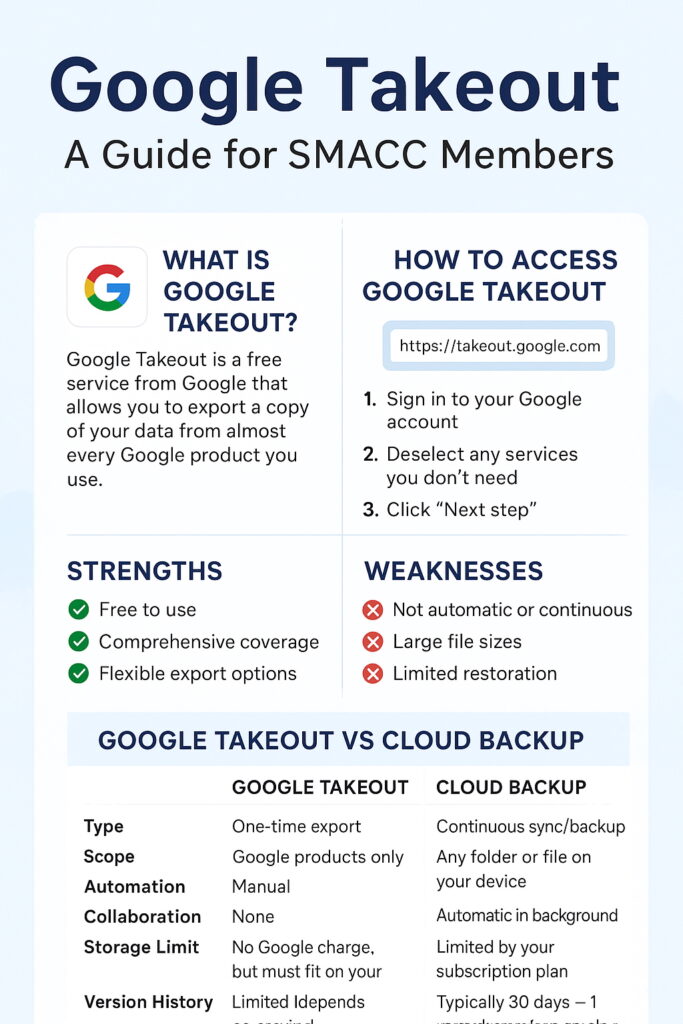Google Takeout: A Complete Guide for SMACC Members – The Backup You Probably Didnt Know you Had !
Google holds an enormous amount of our personal and professional data — from emails and photos to documents, location history, and YouTube videos.
Whether you’re looking to switch services, keep an offline archive, or just have peace of mind, Google Takeout is the tool designed to let you download all your data in one place.
This guide explains what it is, how to use it, and how it compares to other backup options.
1. What is Google Takeout?
Google Takeout is a free service from Google that allows you to export a copy of your data from almost every Google product you use.
Launched in 2011 by Google’s “Data Liberation Front,” it was designed to give users control over their own data — making it possible to move it, back it up, or switch to another provider.
It doesn’t “delete” your data from Google; it simply creates a downloadable archive.

2. How to Access Google Takeout
You can reach it directly here: takeout.google.com.
Steps to use it:
- Sign in to the Google account you want to export data from.
- You’ll see a list of Google services — by default, all are selected.
- Deselect anything you don’t need (this speeds up processing and keeps the file size manageable).
- Click Next step.
- Choose:
- Delivery method (download link via email, or direct transfer to services like Dropbox, OneDrive, or pCloud).
- File type (ZIP or TGZ).
- Maximum file size (2GB–50GB; larger archives will be split into multiple files).
- Click Create export and wait for an email notification when it’s ready.
3. Which Google Services Are Covered?
Google Takeout covers data from over 50 Google products, including:
- Gmail (emails, attachments)
- Google Drive (Docs, Sheets, Slides, PDFs, etc.)
- Google Photos
- YouTube (videos you uploaded, playlists, comments)
- Google Calendar
- Contacts
- Google Maps (saved places, location history, reviews)
- Google Keep (notes, lists)
- Google Play data (books, movies, music purchases)
- Search history and other activity logs
Some third-party apps connected to your Google account may also allow exports through Takeout.
4. How Long Data is Kept by Google
Google retains your data as long as your account is active, unless you manually delete it or set up auto-deletion in your account settings.
Some categories — like location history or web activity — can be set to delete automatically after 3, 18, or 36 months.
Takeout does not change these retention policies; it only captures the data currently stored.
5. How Long Does Google Takeout Take?
Processing time depends on:
- Volume of data (photos and videos take the longest)
- Number of services selected
- Server load at Google’s end
For small exports (under 1GB), it can take minutes to an hour.
For larger archives (100GB+), it can take several hours to days.
You’ll get an email with a download link once it’s ready — links are valid for about 7 days.
6. Strengths of Google Takeout
- Free to use for all Google account holders
- Comprehensive coverage of Google services
- Flexible export options (ZIP/TGZ, size limits, delivery to other cloud providers)
- Data control — you can keep a personal offline copy or move to another provider
- Direct integration with Dropbox, OneDrive, pCloud for cloud-to-cloud transfer
7. Weaknesses of Google Takeout
- Not automatic or continuous — it’s a one-time snapshot, not a live sync
- Large file sizes can be cumbersome to download, store, or unzip
- Limited restoration — you can download your data, but importing it back into Google isn’t always simple
- Short download window — 7-day expiry on links
- Format quirks — some files export in formats (like JSON or MBOX) that need special software to read
8. Google Takeout vs Local Backups
| Feature | Google Takeout | Local Backup (External Drive) |
|---|---|---|
| Cost | Free | Cost of drive |
| Frequency | Manual | Can be automated |
| Scope | Google services only | Anything on your device |
| Security | Google account protections | Physical control (can be encrypted) |
| Speed | Slow for large exports | Fast local transfers |
| Restoration | Limited back into Google | Easy to restore to same device |
9. Google Takeout vs Cloud Backup Services (pCloud, Dropbox, etc.)
| Feature | Google Takeout | pCloud / Dropbox / OneDrive |
|---|---|---|
| Type | One-time export | Continuous sync/backup |
| Scope | Google products only | Any folder or file on your device |
| Automation | Manual | Automatic in background |
| Collaboration | None | Built-in sharing & team tools |
| Storage Limit | No Google charge, but must fit on your destination storage | Limited by your subscription plan |
| Version History | Limited (depends on service) | Typically 30 days – 1 year, depending on plan |
10. Best Practice for SMACC Members
For maximum data safety:
- Do a Takeout export once or twice a year as a deep archive.
- Use a cloud backup service like pCloud or Dropbox for continuous protection of active work.
- Maintain a local encrypted backup on an external drive for offline resilience.
- Store backups in at least two separate locations (e.g., one cloud, one physical) — the 3-2-1 backup rule.
Summary
Google Takeout is a powerful, free way to get a complete copy of your Google data.
It’s ideal for archiving, switching services, or creating a safety net in case of account issues.
However, it’s not a substitute for ongoing backups.
For SMACC members handling valuable creative work, the smartest approach is a layered backup strategy:
- Google Takeout for archival snapshots.
- Continuous cloud backup for active files.
- Local encrypted copies for extra security.


